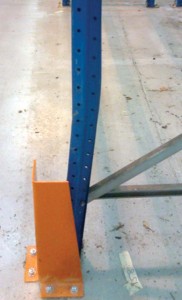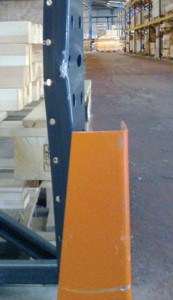 This month we look at how some damage to racking uprights can be repaired and the best way to go about this, and then we have a question about the correct number of pins that should be used with rack guards.
This month we look at how some damage to racking uprights can be repaired and the best way to go about this, and then we have a question about the correct number of pins that should be used with rack guards.
Damage Limitations
Q. I have a few sections of racking with damaged to uprights and bracing members at low level – 2 or 3 foot off the floor, this has now been emptied and requires repairing / replacing.
Some personnel would like to rotate the racking so the damage is at the top and continue to use the racking, I feel from advice of others that the racking SWL / structural strength is still compromised?
Can you please advise on what is considered best practice to make good the damage?
A. First of all you cannot turn the frame upside down as the bracings will be in the wrong position structurally; however it is possible with some types of rack to invert the upright while leaving the bracing as it is. This looks a possibility and would suggest that you need to check the following.
The slot in the Upright front needs to be symmetrical. If it is wider at the top than the bottom then turning is not an option, from the photographs it seems to be a barrel shaped slot with equal top and bottom widths so this looks OK.
When you rotate the upright the damage needs to be above the topmost beam level in the rack. None of your photographs show what happens at the top of the rack however normally the frame protrudes about 0.5m or so above the top beam so again this should be OK as the damaged area of the upright is then above the load carrying beam levels.
As this looks to be quite new racking we would suggest checking with your supplier who should be able to give some good advice on what is possible and what is not together with a logical explanation justifying that advice.
Missing Pins and Loose Column Guards
Q I recently performed a monthly inspection usually performed by a colleague and I found a number of issues, mainly missing pins or loose column guards.
My colleague has suggested that 15 faults identified are not necessary. To aid my response can you advise me on the following points?
If a guard has four holes for fitting to the ground must all four holes be secured with heavy duty anchor bolts or are two bolts in diagonal corners adequate.
Should all missing nuts from a guard be replaced or repaired.
If the racking is used as a picking location with lightweight products does it require locking pins?
A. First of all there is no SEMA requirement for a column guard to be fitted to the floor in any particular way and recommendations on this would be expected to be provided by the manufacturer. Having said this we would have personally expected to find column guards fixed to the floor through four holes, one at each corner. Fitting bolts diagonally would seem to work only if it can be predicted with some certainty which direction a potential impact will come from, which obviously needs to be along the line of the bolt group to gain maximum benefit, difficult to predict.
 It is generally thought that if only two bolts are to be used, then the manufacturer’s statement that this is an acceptable practice should be obtained. Perhaps some test data from the manufacturer’s product testing programme should be requested to confirm that this provides resistance to impacts from all directions.
It is generally thought that if only two bolts are to be used, then the manufacturer’s statement that this is an acceptable practice should be obtained. Perhaps some test data from the manufacturer’s product testing programme should be requested to confirm that this provides resistance to impacts from all directions.
We have tested quite a lot of upright protectors and not found any that will give this level of protection with only two bolts; however that is not to say that there will never be one.
Plainly if nuts are missing off bolts then they need to be replaced if this can be done and a satisfactory joint obtained, no problem, otherwise the whole nut and bolt fitment needs to be replaced. You may want to look at why the nuts were missing in the first place and whether you may need some form of lock nut provided to ensure that having come off once this is not repeated.
As far as locking pins are concerned, these are required for all pallet racks. If some pallet racking has been decked out and is being used as hand loaded shelving and cannot be approached by fork lift trucks or other mechanical aisle equipment then it is sometimes argued that since no large upward forces can be accidentally applied to the under side of the beam then there is no need for a beam connector lock. In this case the racking is the same as ordinary shelving.
The nub of your argument seems to be whether the picking operation is being done with mechanical equipment that could accidentally lift a beam and secondly if the product in this rack is being replenished by a pallet truck which could do the same. If either of these is the case then beam connector locks are necessary. If not then it can probably be defined as heavy duty shelving rather than racking.
We tend to take the view that if some beam connector locks are present then all should be present as changes of use in a warehouse can take place without anyone mentioning to the racking inspector that this is being planned. There is nothing in any of the published standards that require this, however and it is something that given the small cost of beam connector locks is viewed as a common sense issue rather than anything else.
SEMA is delighted to be working with WLN on the storage Question and Answer Column which is published in WLN on a monthly basis. On the WLN website is a list of previously published columns which we hope you find useful.
 For more info, www.sema.org.uk
For more info, www.sema.org.uk




Comments are closed.